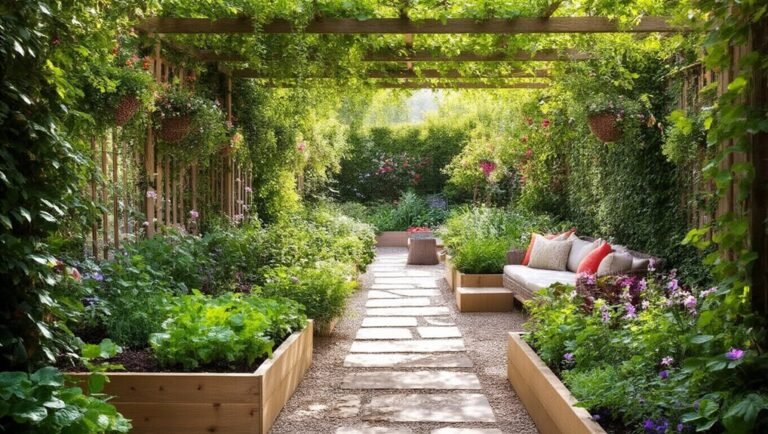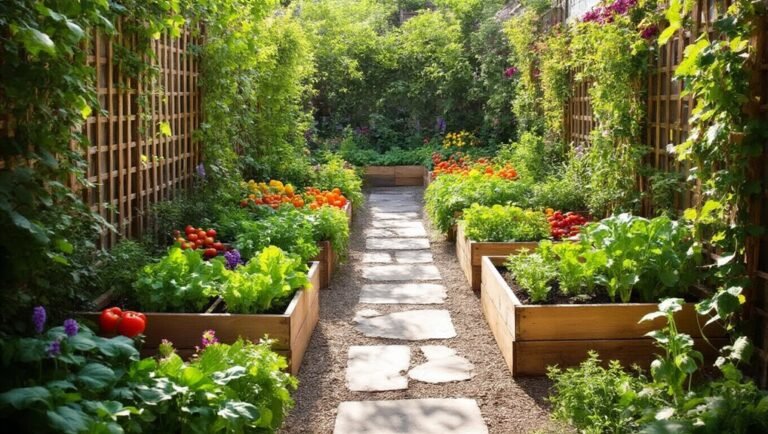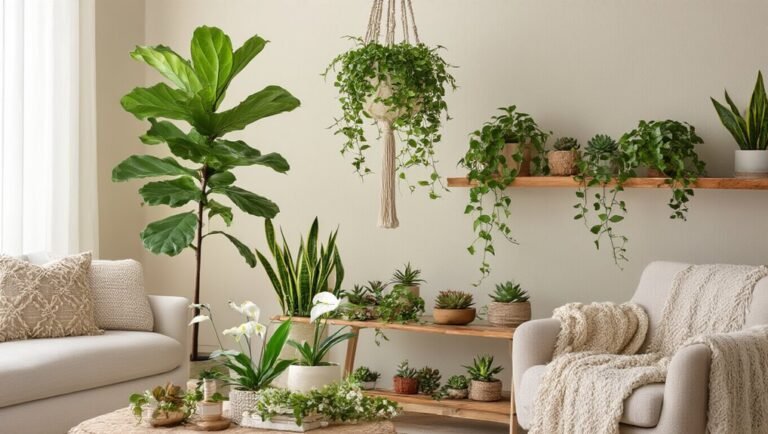If you’re looking to maximize your home garden in small spaces, try vertical gardening with wall planters or opt for container gardens to enhance any surface. Raised garden beds improve soil quality and accessibility, while an herb spiral adds a creative touch. Don’t overlook straw bale and pallet gardens for innovative planting methods. Miniature fruit trees and indoor plants bring nature inside, perfect for small areas. Discover even more unique ideas perfect for your gardening journey!
Key Takeaways
- Create vertical gardens using wall planters to maximize limited space and enhance greenery without occupying ground area.
- Utilize raised garden beds for improved soil quality and accessibility, making gardening easier and more efficient.
- Implement straw bale gardening as a space-saving approach, ideal for poor soil conditions and growing a variety of crops.
- Design a herb spiral to create microclimates, maximizing sunlight and conserving water while showcasing diverse herbs.
- Repurpose wooden pallets into vertical gardens, perfect for small urban spaces, allowing for creative and customizable plant displays.
Vertical Gardening: Maximizing Space With Wall Planters
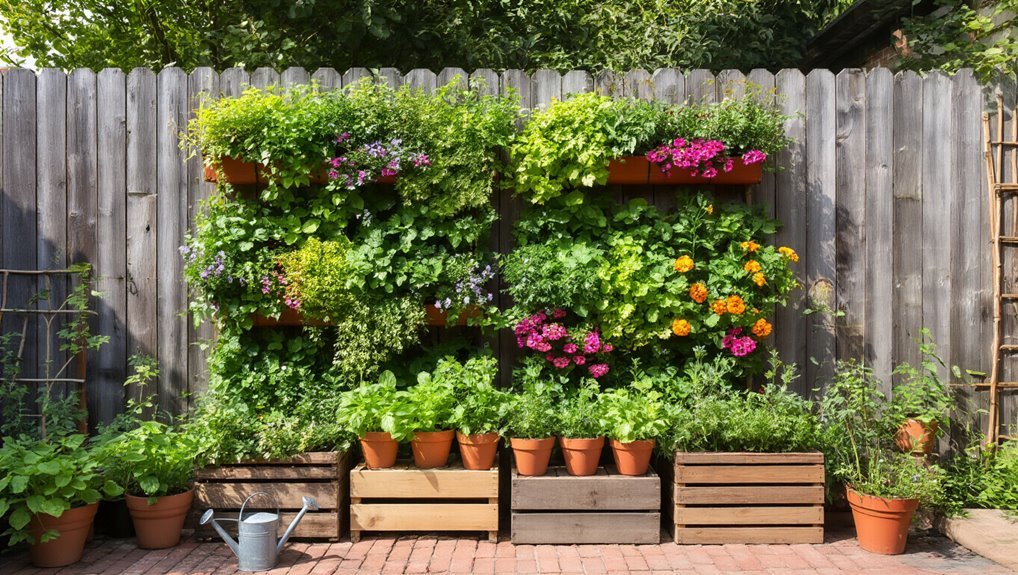
If you’re short on space but still want to enjoy the beauty of a garden, vertical gardening is your best bet.
By using wall planters, you can transform any small area into a lush green retreat. Start by selecting a suitable wall or fence; it should receive adequate sunlight.
Next, choose your plants—herbs, flowers, or even small vegetables work well in vertical spaces.
Utilize shelves, pockets, or hanging containers to organize your greenery, maximizing your available area. For those interested in propagating new plants, plant propagation stations can be a stylish and practical addition to your vertical gardening setup.
Remember to ensure proper drainage and water your plants regularly.
You’ll not only save space but also create a stunning visual display that draws the eye upwards.
With a little creativity, you can cultivate a thriving garden that fits perfectly into your lifestyle.
For a convenient start, consider using vertical garden kits designed to simplify setup and help you elevate your space quickly and efficiently.
Container Gardens: Versatile Options for Any Surface
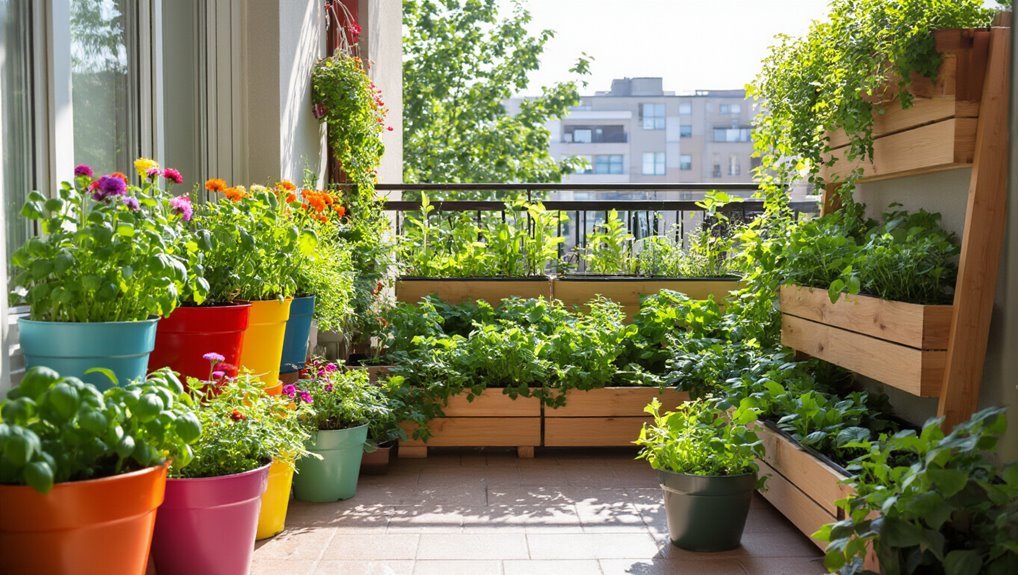
Container gardens offer a flexible solution for anyone looking to bring greenery into their space. They’re perfect for small patios, balconies, or even windowsills. You can choose from a variety of pots, boxes, and even repurposed items like old buckets or crates. This allows you to express your style while maximizing your available area.
Consider mixing herbs, flowers, or vegetables to create a vibrant display. Be mindful of the sunlight each plant needs, and group them accordingly. Regular watering and proper drainage are essential for keeping your plants healthy. For those interested in growing fresh ingredients indoors, indoor herb gardens are a convenient and space-saving way to enjoy year-round flavor.
With a little creativity, you can easily transform any surface into a lush, inviting garden. So grab some containers and start cultivating your green oasis today! For the best results and to elevate your space, explore beautiful plant pots designed to complement your home and garden style.
Raised Garden Beds: Building Up for Better Soil
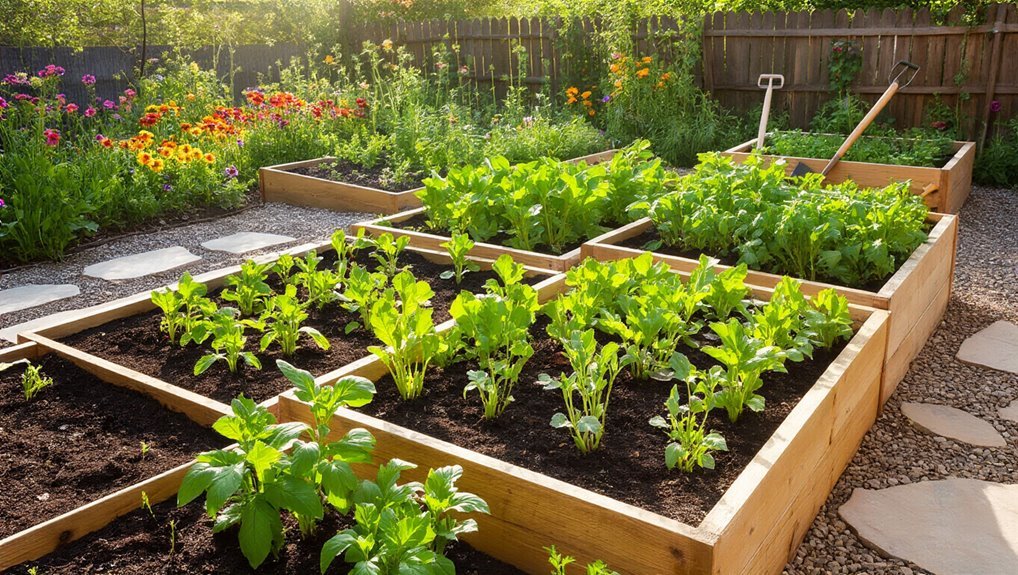
While traditional gardens can be challenging to manage, raised garden beds offer a straightforward solution that enhances soil quality and drainage. By elevating your garden, you can create an ideal environment for your plants. For gardeners interested in sustainable practices, integrating compost bins into your setup is a great way to recycle organic waste and enrich your soil naturally.
Here are some benefits of raised garden beds:
- Improved soil drainage prevents waterlogging.
- Easier access reduces strain on your back and knees.
- Customizable soil mix allows for optimal nutrient levels.
- Extended growing season warms up faster in spring.
- Keeps pests and weeds at bay, minimizing maintenance.
For gardeners looking to make the most of their space, raised garden beds provide an effective way to maximize plant health and productivity. Building your own raised beds is a rewarding DIY project that can fit any space.
With just a few materials, you’ll enjoy gardening with less hassle and more success.
Herb Spiral: A Creative Approach to Herb Gardening
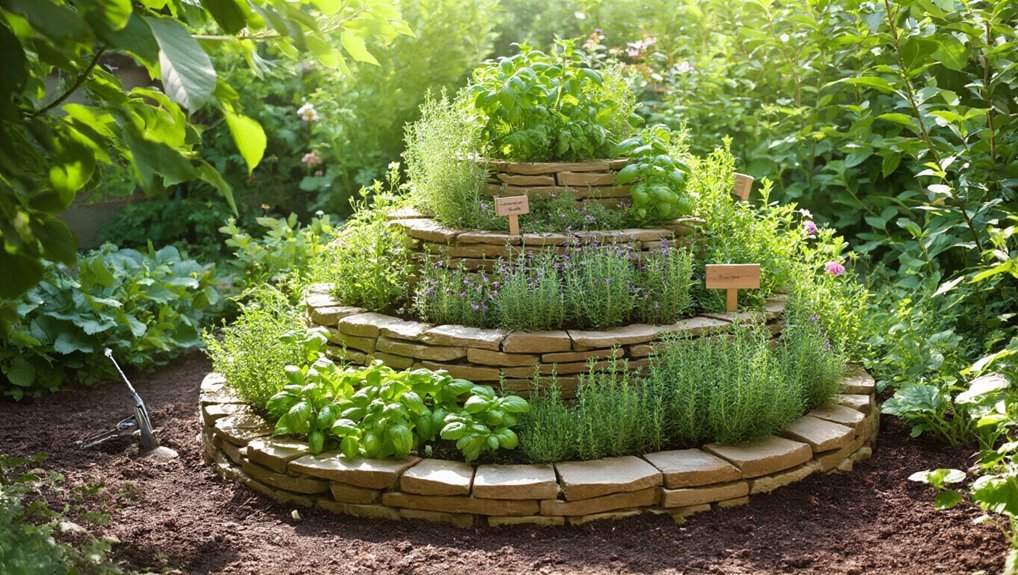
Imagine transforming a small space into a vibrant herb garden with an innovative herb spiral. This vertical garden design not only saves space but also creates a beautiful focal point. By stacking stones or bricks in a spiral shape, you’ll create different microclimates, ideal for a variety of herbs. Start with the larger herbs at the base, like rosemary and sage, and work your way up to smaller varieties like thyme and basil. This arrangement allows you to maximize sunlight exposure and conserve water, as the spiral retains moisture well. For gardeners looking to start their plants efficiently, seed starting kits provide a reliable foundation for strong, healthy seedlings. Plus, it’s a fun DIY project that you can customize to fit your style.
You can also kickstart your project using Herb Garden Kits with Seeds and Pots that make starting an herb spiral easy and accessible for any gardener.
Get ready to enjoy fresh herbs right at your fingertips, enhancing your culinary creations!
Hanging Gardens: Elevating Plants for a Unique Look
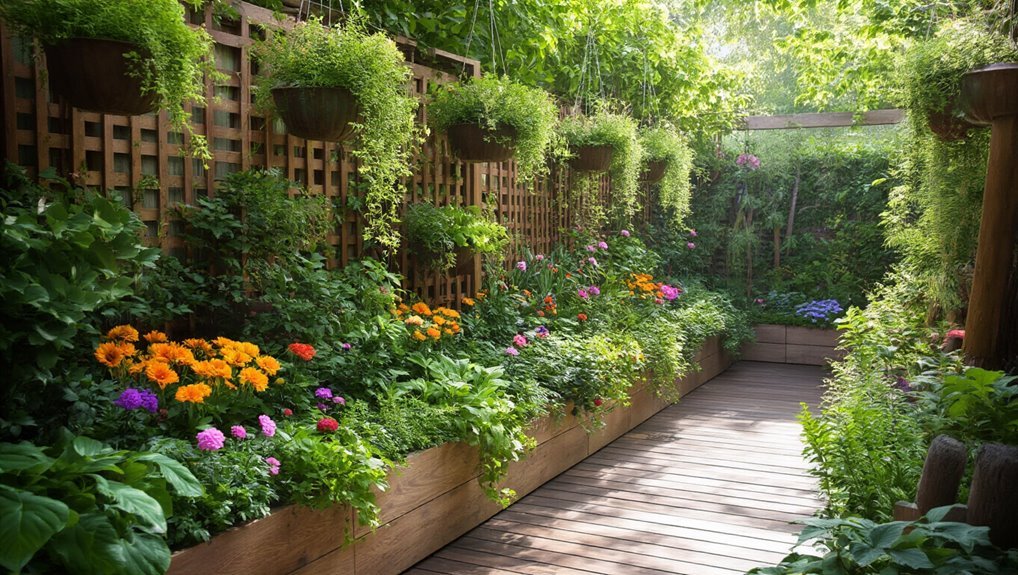
If you’re looking to add a touch of whimsy and creativity to your garden, hanging gardens might be the perfect solution.
By elevating your plants, you not only save space but also create a stunning visual impact. Incorporating stylish plant stands can further enhance the look and versatility of your hanging garden arrangements. Here are some ideas to get you started:
- Use wall-mounted planters for herbs or flowers.
- Hang macramé plant holders for a boho vibe.
- Repurpose old pallets to create a vertical garden.
- Install a tiered shelf to mix and match different plants.
- Try cascading planters for a dramatic effect.
Hanging gardens can transform any small space into a vibrant oasis.
With a little imagination, you can design a unique setup that showcases your favorite plants while adding charm to your home.
For more inspiration, consider exploring beautiful hanging planters that can elevate your space with style and function.
Window Boxes: Adding Greenery to Your Windowsill
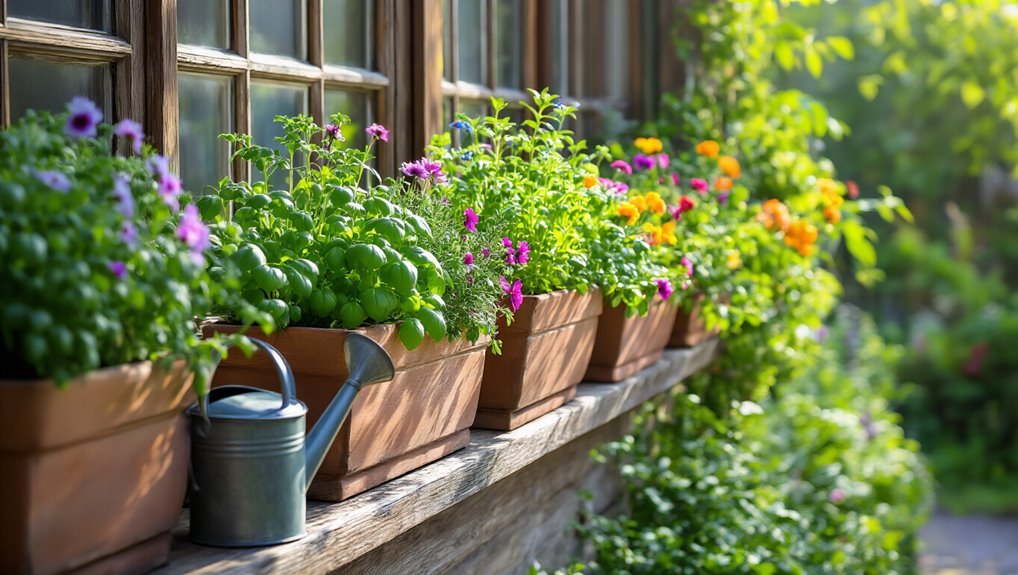
Window boxes can instantly enhance your home’s exterior, bringing a splash of color and life to your windowsill.
They’re perfect for small spaces, and you can customize them to fit your style. Choose vibrant flowers, fragrant herbs, or even trailing vines to create a stunning display. Many gardeners also enjoy the flexibility of grow bags for planting in limited spaces, as they are lightweight and easy to move.
Before planting, make sure your window box has good drainage to keep your plants healthy. You can also select a lightweight option if you’re concerned about weight.
Consider seasonal changes; switch out plants to keep your display fresh year-round.
Don’t forget to water regularly and provide nutrients to your plants.
For even less maintenance, Self-Watering Planters can be used in window boxes to simplify watering and keep your plants thriving.
With a little effort, window boxes can transform your home, adding charm and personality without taking up much space.
Straw Bale Gardening: An Innovative Planting Method
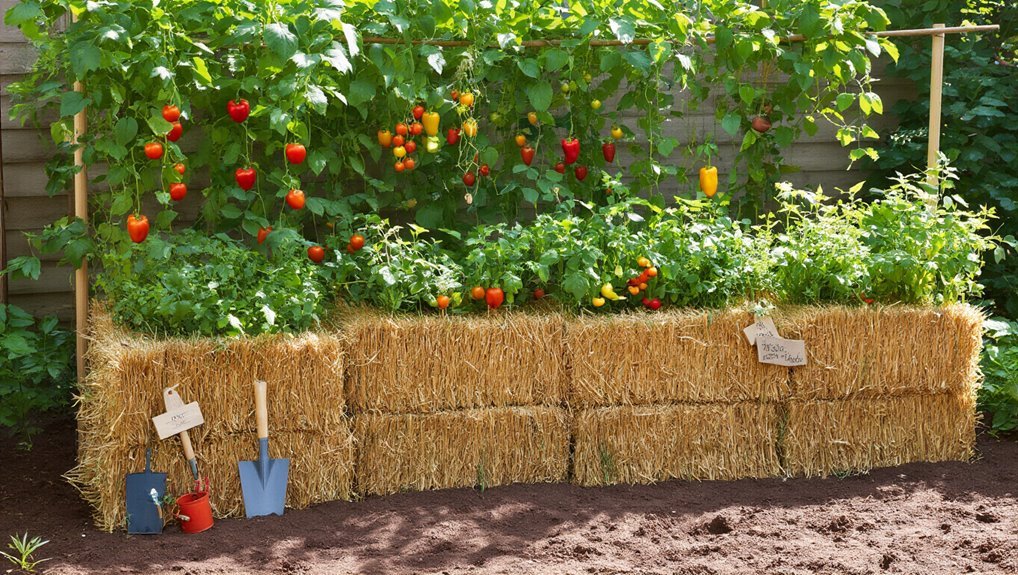
Straw bale gardening offers a unique and effective way to grow plants, especially for those with limited space or poor soil conditions.
This method allows you to create a rich growing environment without traditional soil, making it ideal for urban settings or areas with compacted earth. For even more robust plant growth, many gardeners enhance their bales using plant fertilizer tablets to supply essential nutrients throughout the season.
Here’s what you need to know:
- Select high-quality straw bales: Ensure they’re from wheat, barley, or oats for best results.
- Condition the bales: Water them for about 10 days to kickstart decomposition.
- Plant directly into the bales: Use the top or sides for planting, depending on your space.
- Water and fertilize: Regular maintenance is key to healthy growth.
- Enjoy a variety of crops: From tomatoes to herbs, you can grow many plants!
For gardeners interested in traditional methods, choosing the best garden soil can also help plants thrive and achieve optimal growth.
Give it a try, and watch your garden flourish!
Pallet Gardens: Repurposing Wood for Urban Greens
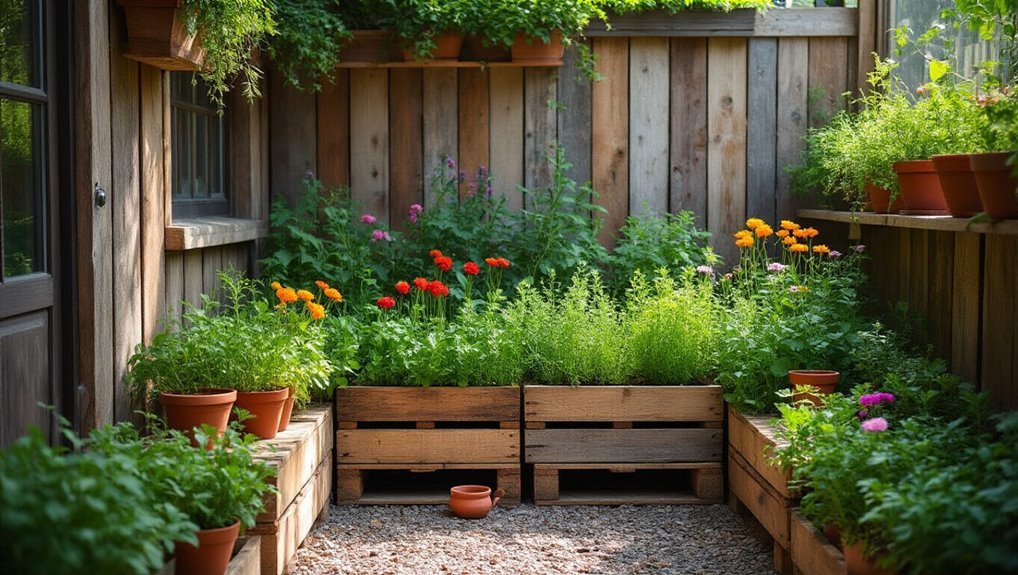
While urban living often limits gardening opportunities, pallet gardens offer a creative solution to transform unused spaces into vibrant green areas.
You can easily repurpose wooden pallets to create vertical gardens, adding greenery without consuming much ground space. Start by ensuring your pallets are clean and free from harmful chemicals, then lay them flat or stand them up against a wall. When working with pallets and soil, it’s important to protect your hands using essential gardening gloves to prevent scrapes and blisters.
Fill the openings with soil and select your favorite plants, whether they’re herbs, flowers, or succulents. This DIY project not only beautifies your surroundings but also promotes sustainable practices by recycling wood.
Plus, pallet gardens can be customized to fit your style, making them a perfect addition to balconies, patios, or any small urban nook.
To make harvesting from your pallet garden easier, consider using Garden Harvesting Tools such as sickles, which are specially designed for efficient garden work.
Get started today!
Miniature Fruit Trees: Dwarf Varieties for Small Spaces
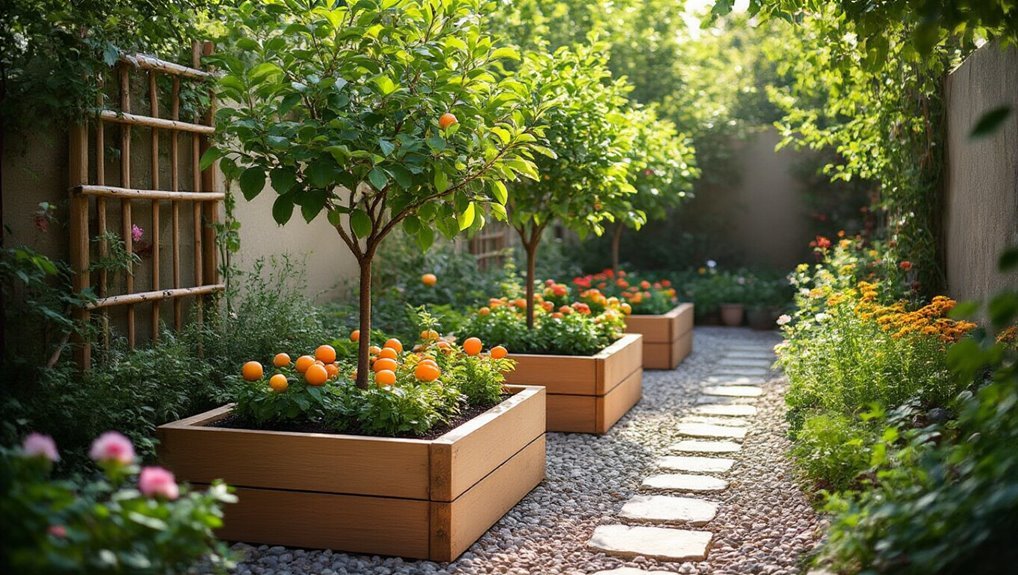
If you’ve enjoyed creating pallet gardens, you might want to explore another fantastic option for maximizing small spaces: miniature fruit trees.
These dwarf varieties not only add beauty to your garden but also provide delicious fruits, all while fitting in tight spots.
Here are a few popular miniature fruit trees to consider:
- Dwarf Apple Trees: Easy to grow and perfect for containers.
- Miniature Citrus Trees: Enjoy fresh lemons or oranges on your patio.
- Dwarf Cherry Trees: Compact and perfect for small gardens.
- Peach Trees: Sweet, juicy peaches in a manageable size.
- Fig Trees: Great for small spaces with their unique fruits.
Indoor Gardening: Bringing Nature Inside With Houseplants
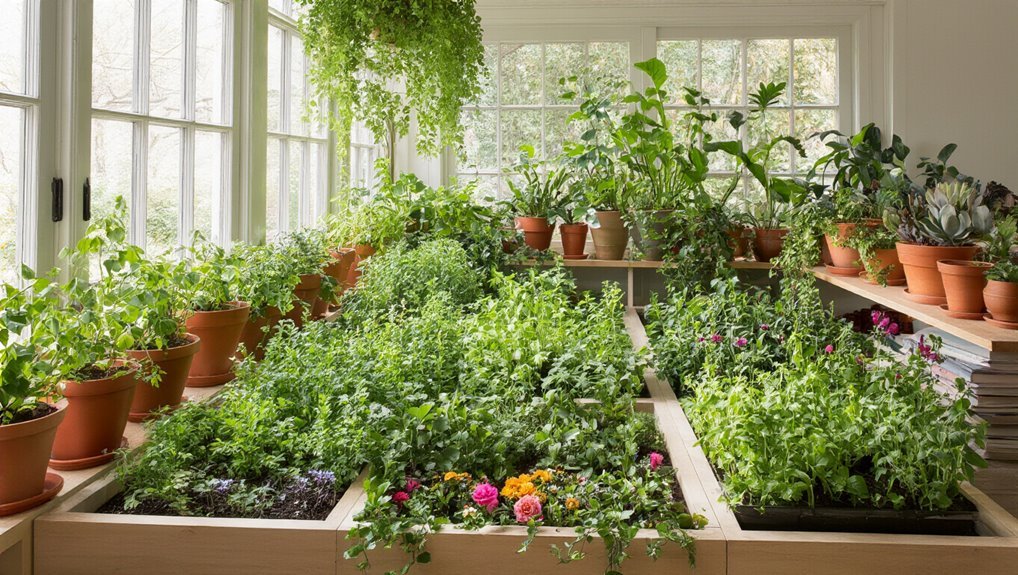
Bringing nature indoors can transform your living space into a vibrant oasis, and houseplants are an excellent way to achieve that. They not only purify the air but also boost your mood and creativity. Imagine the joy of caring for a lush fern or the tranquility of a serene peace lily.
Here’s a quick guide to help you choose the right houseplants:
| Plant Type | Light Requirements | Emotional Benefits |
|---|---|---|
| Snake Plant | Low to bright | Resilience and strength |
| Pothos | Low to bright | Joy and easy care |
| Spider Plant | Moderate | Nurturing and growth |
| Peace Lily | Low to moderate | Calm and tranquility |
Start your indoor garden today, and enjoy the beauty and benefits of greenery in your home!
Frequently Asked Questions
What Are the Costs Associated With Creating a Small Garden?
Did you know that the average cost to start a small garden is around $200? You’ll need to budget for soil, seeds, tools, and possibly fencing, depending on your space and preferences.
How Do I Choose the Right Plants for My Small Space?
To choose the right plants for your small space, consider sunlight, climate, and your preferences. Opt for compact varieties, prioritize low-maintenance options, and mix colors and textures to create an appealing, vibrant environment.
Can I Compost in a Small Garden?
Absolutely! You can turn kitchen scraps into garden gold, even in a tiny space. Just find a compact compost bin or create a delightful worm farm, and watch your plants thrive with nutrient-rich goodness.
What Tools Do I Need for DIY Garden Projects?
For DIY garden projects, you’ll need basic tools like a trowel, pruning shears, a spade, gloves, and a watering can. Having a measuring tape and garden fork can also make your tasks easier and more efficient.
How Do I Maintain My Garden Throughout the Year?
To maintain your garden year-round, regularly water, prune, and fertilize plants. Monitor for pests, rotate crops, and mulch to retain moisture. You’ll enjoy a thriving garden with consistent attention and care throughout the seasons.
Conclusion
No matter how small your space, there’s always a way to grow your own garden. From vertical gardens to miniature fruit trees, you can turn your little patch of earth into a green oasis. So, whether you’re a seasoned gardener or just starting, don’t throw in the towel! With a little creativity and effort, you can cultivate a thriving garden that brings beauty and fresh produce right to your doorstep. Happy gardening!
